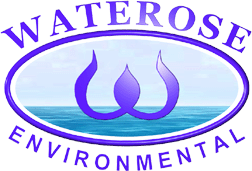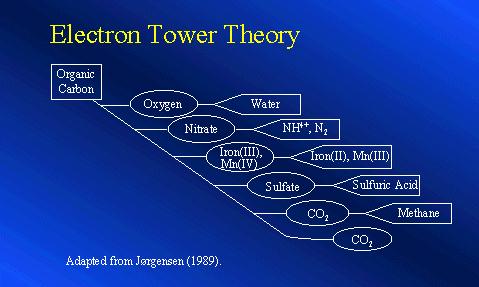 | ||||||
| Articles | Projects | Resume | Cartoons | Windsurfing | Paintings | Album |
Bioremediation of an Oil Spill
by Waterose

Bioremediation is the method of choice to effectively clean up a small spill of hydrocarbons. In this case, five-hundred liters of BTEX has spilled from an above ground storage tank into a pasture that is located at the west edge of the Royal Roads University (RRU) grounds. The soil is classified as a Gleyed Eutric Brunisol based on recent laboratory analysis; it contains clay, but is fairly loose and porous for the upper meter, and then reaches an impermeable clay boundary (Burke, 1998). The dominant vegetation is field grasses and approximately fifty percent cover of Scotch Broom. The spill occurred during March which is a period of seasonal transition. The weather is variable with periods of sun and periods of rain. The slope aspect is south, and the water table drains into the Esquimalt Lagoon, which is a bird sanctuary and is also used for human recreational purposes. In addition, there are two creeks to the North and the South of the spill area, Hatley Creek and Bee Creek respectively. These two creeks support a small indigenous population of Cut-throat trout. This pasture is adjacent to the Family Day Care Center and a large residential section of the City of Colwood (Colwood, 1998).
The primary concern is the potential risks that BTEX poses to humans and to the environment. BTEX is an acronym for a group of monocyclic aromatic hydrocarbons that includes benzene, toluene, ethylbenzene, and xylene (Atlas, 1998). These compounds are commonly found in gasoline and are highly volatile. Even so, they do adsorb to clay particles. They can leach into groundwater because their solubility is between 0.174 to 0.187 grams per liter at twenty-five degrees Celsius (Dodd, 1997). BTEX is a known carcinogen, and is linked to incidences of leukemia, and thus, poses a risk to human health.
There are some immediate concerns that should be addressed. First, the storage tank must be examined to determine if there are any faulty parts or areas that need to be repaired to prevent any further spillage. Second, the spill area should be fenced off to protect children and animals from potential contact with the BTEX. The next step is to develop a viable bioremediation strategy.
The size of this spill is relatively small and consequently, in situ bioremediation treatment is preferred to ex situ. In situ treatment is less expensive than the removal and treatment at an off-site location. In addition, a portion of the five-hundred liters would have vaporized from the surface of the ground. A simple bioremediation strategy is preferable to a more complex method.
It is however, important to consider several alternative methods. One strategy is to install a pumping well and inject hydrogen peroxide into the soil and aquifer; however, the size of the spill and the soil conditions do not favor this method. Similarly, a drawdown well strategy can be used to extract light non-aqueous phase liquids (LNAPL); however, this process is very expensive (Grundy, 1998). In addition, a portion of the BTEX adsorbs to the clay particles and is not highly soluble in normal March temperatures of approximately twelve degrees Celsius. Another strategy is to excavate the contaminated soil and disperse it over a liner adjacent to the spill area to expedite bioremediation by higher rates of vaporization and degradation by photolysis; however, this exacerbates the risk factor to children and pets in the adjacent residential area (Atlas, 1998). It is, in this situation, optimal to bioremediate in situ with the least amount of disturbance to the spill area. This is the most cost effective method, and poses the least risk. This method has a slower rate of decontamination, but, considering that this is early spring, it is viable that bioremediation will be expedited by summer weather which is warm, sunny, and dry. It is probable that the site can be bioremediated or cleaned up by early winter. There are some preliminary phases to initiate the bioremediation procedure.
The first step is to complete an efficacy test in a controlled environment (Noble, 1998). The method is to obtain a field sample of the contaminated soil at the outer perimeter of the spill area. This soil sample will contain indigenous microbes and the contaminants. The most common indigenous bacteria are the Pseudomonas spp. which are an aerobic species, and are capable of using the BTEX as a carbon source. In addition to using the carbon source, they also require nutrients that include nitrogen and phosphorous. The field soil sample is monitored under abiotic controls to distinguish biodegradation from evaporation of the volatiles. Specific parameters that are measured in the laboratory environment include the degradation rate of the BTEX, the concentration of the indigenous microorganisms, and the optimum growth factors (Atlas, 1998). BTEX is commonly bioremediated under aerobic conditions, so it is also important to monitor the respiration rates of the microorganisms which consume oxygen and produce carbon dioxide. The efficacy tests can be conducted in the laboratory at the Royal Roads University. It is possible to use bioaugmentation and introduce specific microorganisms and enzymes that will expedite the mineralization of the BTEX during the efficacy tests. It would be advisable to test the white rot fungus (Phanerochaete chrysosporium spp.) in the efficacy procedure to determine if this bioaugmentation will expedite the bioremediation of the soil. This species effectively biodegrades polyaromatic hydrocarbons (Noble, 1998). In addition to monitoring these factors, it is also important to determine if there are any adverse side effects. When a microbe or combination of microbes has been isolated in the efficacy tests, it is necessary to mass produce the species in an enrichment medium. The bulk mass of microbes is then placed into an emulsified solution and transported to the spill site. In addition to efficacy tests, it is practical to review published literature of bioremediation of similar spills to determine which method or combination of methods is strategic.
The bioremediation of BTEX compounds is highly successful under aerobic conditions (Brauner, 1998). The aerobic degradation of benzene is illustrated in Figure 1.

The limiting factors that may inhibit the rate of degradation are the concentrations of available oxygen, nitrogen and phosphorous. The oxygen functions as the electron acceptor when the carbon source is metabolized by the bacteria. In this case, the soil is porous and shallow, so there may be an adequate supply of oxygen and it may not be necessary to inject additional oxygen, such as hydrogen peroxide. It would be viable to add surface nutrients of nitrogen and phosphorous in the form of a soluble fertilizer.
In addition to aerobic bioremediation of BTEX, recent studies show that at deeper levels in the soil contaminated with a BTEX spill, anaerobic bioremediation occurs with electron acceptors other than oxygen such as nitrate, iron (III), and sulfates (Brauner, 1998). The ranking of the electron acceptors is referred to as the Electron Tower Theory. The most efficient acceptors are rated at the top, and the least efficient energy producers are at the bottom. The ranking of electron acceptors and the reaction products are illustrated in Figure 2.

The anaerobic bioremediation of BTEX naturally occurs to some degree in the soil profile. The typical biodegradation is illustrated in Figure 3.

The most important concern is the potential risk to humans and to the environment. In addition, the cost to remediate is a concern. The fuel tank is part of the legacy of the Department of National Defense, which was purchased by the Royal Roads University. This new university does not have excessive funds, but it does have an enthusiastic and knowledgeable team that can cope with the spill problem. The next phase is to bioremediate the spill area.
The process to bioremediate the spill area involves several stages. The first stage is to prepare the ground for inoculation. In this case, it would be optimal to manually create a grid of deep holes with a narrow clean rod. This would aerate the soil and provide a mechanical means to seed the area evenly. The next step is to introduce the microbes by systematically pouring the emulsion evenly over the contaminated area in the morning. The next step is to apply slow release soluble fertilizer that contains nitrogen and phosphorous to provide the nutrients. This phase of the bioremediation is now complete.
The final phase is to monitor the field area on a weekly basis. This task can be accomplished using a combination of field tests and tests of field samples in the laboratory. It would be ideal to test the center of the spill area, four spots evenly around the center that are half the radius from the center, and four more locations at the perimeter. In addition, spot samples should be tested down slope at even intervals between the spill and the lagoon. Finally, it is very important to test the surface stream water of the two adjacent streams and the point of entry into the lagoon for the presence of any BTEX. These tests can be accomplished by a team of students under the careful supervision of the specialists at the University.
The findings of the weekly tests must be carefully monitored to evaluate the rate of BTEX biodegradation. If the rates are too low, then one of the alternative methods described earlier may be incorporated into the bioremediation strategy. The optimum goal is to biodegrade the BTEX prior to the October as the latest possible target period.
It is important to document every step of the procedure as it occurs. In the event that the bioremediation of the spill is successful, the report about the project can be published.
References:
Written for Royal Roads University ES317 Microbiology and Biochemistry Lecture SeriesAtlas, R. And Bartha, R. 1998. Microbial Ecology Fundamentals and Applications. Fourth Edition. Benjamin Cummings Publishing Company. Menlo Park, Ca. 694 pp.
Brauner, J. and Killingstad, M. 1998. In situ Bioremediation of Petroleum Aromatic Hydrocarbons. Internet. Available at URL: http://www.ce.vt.edu/enviro/gwprimer/btexbio.html.
Burke, J. 1998. Unpublished Works. Analysis of Soils at Royal Roads University.Rock’t Soils Environmental Consulting. Victoria, B.C. 31 pp.
City of Colwood. 1998. Official Community Plan. Schedule “A” to Bylaw No. 373. City of Colwood Planning Department. City of Colwood. Colwood, B.C. 155 pp.
Dodd, M. 1997. ES306 Environmental and Analytical Chemistry Lecture Series. Sources, Reactions, Transport, Fate and Effects of Selected Organic Compounds. November 4, 1997. Royal Roads University. Victoria, B.C.
Grundy, S. 1998. ES316 Environmental Hydrology and Soil Science Lecture Series. Bioremediation of Contaminated Aquifers. March 9, 1998. Royal Roads University. Victoria, B.C.
Noble, M. 1998. ES317 Applied and Environmental Microbiology and Biochemistry Lecture Series. Biodegradability Testing and Monitoring the Bioremediation of Xenobotic Pollutants. February 26, 1998. Microbial Seeding and Bioengineering Approaches. February 27, 1998. Royal Roads University. Victoria, B.C.
Return to Index of Articles

 email Waterose
email Waterose
Please Sign My Guestbook
Please View My Guestbook

| Articles | Projects | Resume | Cartoons | Windsurfing | Paintings | Album |
 | ||||||